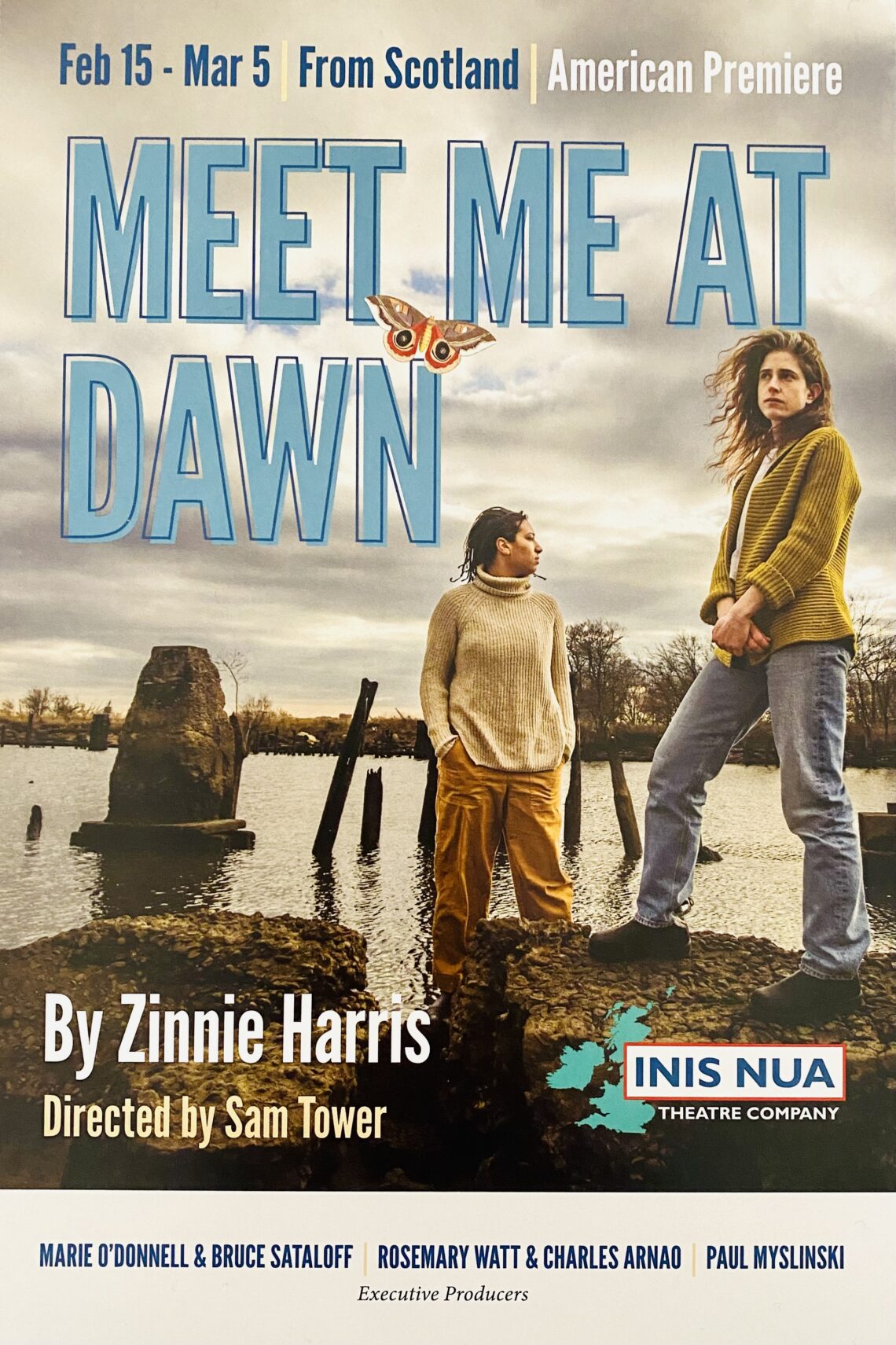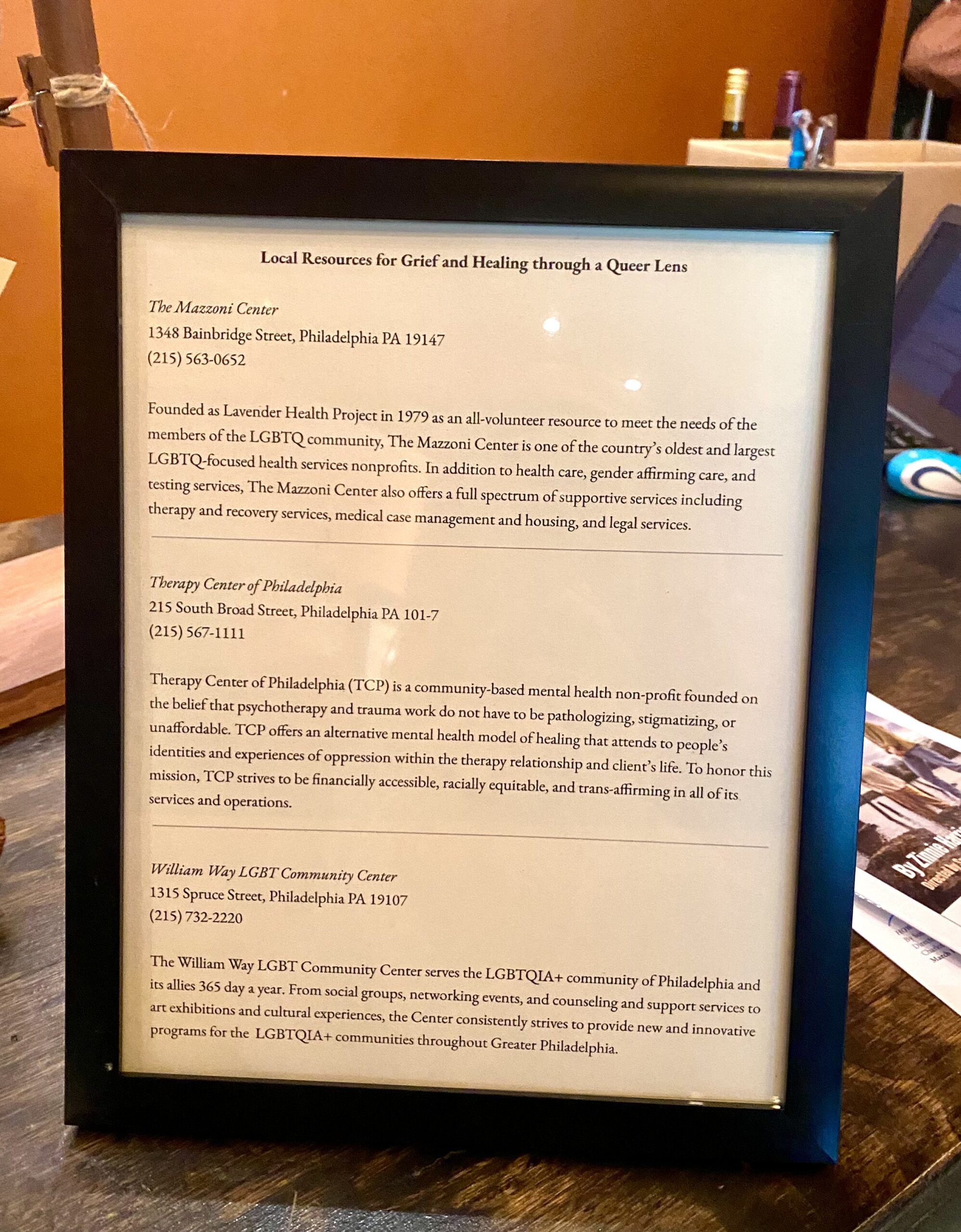
Philadelphia’s Inis Nua Theatre Company Showcases American Premiere of ‘Meet Me at Dawn’ by Zinnie Harris

Playbill cover and poster design are visually taut and arresting.
“Grief is like the ocean; it comes on waves ebbing and flowing. Sometimes the water is calm, and sometimes it is overwhelming. All we can do is learn to swim.” — Vicki Harrison
“Everyone can master a grief but he that has it.” — William Shakespeare, Much Ado About Nothing
“My life closed twice before its close;
It yet remains to see
If immortality unveil
A third event to me,
So huge, so hopeless to conceive
As these that twice befell.
Parting is all we know of heaven,
And all we need of hell.” — Emily Dickinson
Story, photos by Sharon Kozden
For my parents, Andrew Anthony Kozden and Tillie Emily Kozden. May their souls rest in eternal peace.
Sunday afternoons are perfectly suited to certain activities. Take live theater, for instance.
The idea of boarding a train bound for the city for an afternoon matinee appeals to my suburban-mouse-visits-the-megalopolis self. Once I successfully navigate the railway journey and am safely ensconced in a darkened room filled with strangers, I lapse into a contemplative state, wholly engrossed and held captive by whatever drama is unfolding onstage.
And do emphasize the dramatic; I prefer that which teaches me what it means to be human over car chases and lightweight variety shows. Bring on the provocative. Probe the depths. Pick my brain with profundity even if it disturbs me. I won’t look away. Give me the human condition and hold the sugarcoating.
That noted, when my favorite Philadelphia public relations pro Kory Aversa of AversaPR offered me an opportunity to check out the American premiere of Meet Me at Dawn by the award-winning Scottish playwright Zinnie Harris and produced by Philadelphia’s own Inis Nua Theatre Company, it took me all of 30 seconds to respond affirmatively. On February 26th, I arrived at the Louis Bluver Theatre at the Drake (hotel) in Philadelphia for one and a half hours of the dramatic profundity I crave.
In spite of my penchant for deep waters, stepping onto the train that day at Wynnewood Station was, admittedly, emotionally challenging. I was walking into the potentially “overwhelming waters” referenced in Vicki Harrison’s quote. Zinnie’s play is a searing meditation on grief and loss that examines both subjects with a fine-toothed comb and blasts any what-it-means-to-be-human factor through the proverbial stratosphere. Under ordinary circumstances, her play would be a hard watch. However, and one month prior on January 25th, my beautiful mother was placed full fathom five, so I was one apprehensive, tissue box-toting playgoer.
We also buried my beloved father four years earlier on a biting cold February day. Yikes: new grief and prior loss. Unhealed anguish and recent bereavement. I am newly inducted as an unintended foundling member of the godawful grief club, cast into a netherworld I wish to Maker you will never visit but understand that you most likely will. I’m a forlorn outcast, dumpster-diving sorrowful depths while learning to traverse the balance of my earthly existence without a living parent.
Inside the theater, I hung on every word, absorbed like a paper towel every gesture and action and clung to the notion that Zinnie’s art would provide some semblance of relief, for Maker-knows, I wasn’t getting what I needed (less any cursory measures of condolence) from anyone in my life. When it comes to death, we frequently tend to just not go there. We skim on a surface level, rarely broach and almost never deep-dive. Sad, but true. Which is why I adore live theatre. I required an infusion of visceral truth, a shoulder to both cry and why on and a hand to hold mine. We actually need to talk about death more, not less. Grief is a lonely place–a sodality no one aspires to join.
In a nutshell, Zinnie delivers–and then some. While I won’t reveal the major plot twist, I can eagerly speak to the two actors’ emotional and brutally honest portrayal of their characters, the spare and somber-stringed musicality during key scenes, the desolate stage setting (unsettling as antithesis of home and hearth) and the overall magnificent production by the Inis Nua Theatre Company under the direction of Sam Tower. There truly is nothing akin to live theater–in case I haven’t already stressed that point. And when an audience connects on every level, it’s a magical and memorable experience for all present.
In her director’s notes found in the playbill, Sam Tower writes, “Stories written by Zinnie Harris ask ‘what if …’; She takes us to a familiar place, only to turn it upside down. She thrusts her characters into the deepest, darkest moments of life and reveals their most precious dreams. With Meet Me at Dawn, we are asking the audience to walk into that magical darkness, as we tell the story of two women shipwrecked in a world much like our own. This world that is brutal and sweet, where the greatest, most dangerous thing we can do is love each other.”
The two women, Helen (Jackie Soro) and Robyn (Hannah Gold), marooned and washed up on a sandy beach, have “survived” a horrific boating accident. Wet-clothed and sand-covered, the women react in polar-opposite fashion to their newly realized circumstances with Helen as the poster child for excitable toxic positivity and Robyn as her fretful, anxious and somatic foil.
Helen is determined and purposeful, a woman of action, set on extricating the duo from their current crisis situation and returning them to terra firma, where a dog they are minding symbolizes a settled, nurturing home-and-hearth life in known, charted territory. I pondered over that dog as a symbol and decided it represented realities and attachments beyond their immediate frantic situation–this awaiting dog along with no doubt a to-do list affixed to the fridge and future calendar appointments.
Robyn is paralyzed by inaction and can do little more than voice doom and gloom scenarios while waxing futile and hopeless. The disparate ways in which Helen and Robyn initially respond made me wonder how they had become partners to begin with. Then I remember my relationship with my Ex and can only nod knowingly. People are distinct individuals in possession of clear identities and boundaries; they are beyond complicated, and relationships–even the best ones–demand an inordinate amount of compassion, tolerance, the oft-taxing ability to walk in another’s shoes of a lifetime and so very much more–and on the daily to boot.
As I questioned the couple’s compatibility or lack thereof, it hadn’t dawned on me that something else altogether was occurring, for I had been accepting what I was observing at face value. However, the truth of the matter–something totally unrelated to their individual abilities to successfully maintain and nourish a romantic relationship (or not) –was actually being separated before me through intensifying dialogue like an egg’s yolk from its albumen. Talk about multi-layered complexity.
I didn’t see the startling revelation coming. Truth be told, I rather welcomed Ms. Harris’s slow burn method of disclosure, for it offered a shock absorber of sorts–a bit of processing time in which to wonder, “Did she say what I think she said?” “Did what she just said mean what I think it means?” Ms. Harris’s powerful exposition of grief and loss is deeply moving, shattering and smart. It’s smart in the sense that it perfectly captures often noted aspects of the grieving process such as how there is just no right or wrong way to be or do while moving through its stages and how no one individual will experience grieving in the same manner as will another.
It’s even smarter when also beautifully delineating in trickle-down moments the lesser addressed and unexpected facets of grief. For instance, and soon after my mother died, I unintentionally began favoring a particular sweater, when I realized that it enveloped and cocooned me like a security blanket. I hadn’t thought much about this sartorial alteration until I heard “grief cardigan” mentioned during the play and immediately connected the threads.
Some of the more powerfully affecting and connective moments of the afternoon occurred after the play, where it was made abundantly clear the availability of support, concern and care for those traversing grief’s choppy and turbulent waters. An achingly poignant display in the lobby created by Dramaturg Chelsea Drumel served as a sacred space for the mourning to “hang thoughts in the air, sink them into the sand or tuck them into the driftwood.” Keeping step with the play’s plot, Ms. Drumel chose oceanic design elements such as sea glass, driftwood and sand to create one of the most memorable and empathic installations that welcomed and beckoned those who may have found the playwright’s “magical darkness” only too relatable. Forever thank you, Chelsea.
I hung out a bit after the show to participate in a Q&A panel discussion, which was comprised of Artistic Director Kathyrn MacMillan, Dramaturg Chelsea Drumel, cast members Jackie Soro and Hannah Gold and an audience that was wholly engaged and, judging from the questions fielded, clearly grateful for the unique opportunity to delve deeply into the murky territory of that familiar place upended by Ms. Harris’s work.
Don’t be afraid to join her at low tide. It just may provide succor when acquaintances, colleagues, friends and family (at times especially family) bury themselves like crabs in avoidant sands and waves of superficiality are breaking all around you. But of course, they mean well.

On a springlike Sunday afternoon, I rode the train into Philly to the Louis Bluver Theatre in the Drake Hotel.
 City Hall greeted me as I exited 15th St. Station.
City Hall greeted me as I exited 15th St. Station.
 I arrived at the Art Deco architecturally designed Drake Hotel with mere minutes to spare before the theatre lights dimmed to indicate ‘commence showtime.’
I arrived at the Art Deco architecturally designed Drake Hotel with mere minutes to spare before the theatre lights dimmed to indicate ‘commence showtime.’
 The signage helped me located the theatre entrance, which was on the building’s side.
The signage helped me located the theatre entrance, which was on the building’s side.
 Inis Nua Theatre Company’s performance location is on the east side of the Drake Hotel building on S. Hicks Street. The Proscenium Theatre is right neighborly and just next door.
Inis Nua Theatre Company’s performance location is on the east side of the Drake Hotel building on S. Hicks Street. The Proscenium Theatre is right neighborly and just next door.
 Funny happenstance: the wind blew this sign over and carried it into S. Hicks Street; I ran to fetch it.
Funny happenstance: the wind blew this sign over and carried it into S. Hicks Street; I ran to fetch it.
 Scenic Designer Jillian Keys created the play’s spare setting, where the characters wash up on a fog-drenched, sandy and rocky beach strewn with a messy collection of castoffs.
Scenic Designer Jillian Keys created the play’s spare setting, where the characters wash up on a fog-drenched, sandy and rocky beach strewn with a messy collection of castoffs.
 From Left, actors Jackie Soro (Helen) and Hannah Gold (Robyn) graciously honor my request for a photo post-production.
From Left, actors Jackie Soro (Helen) and Hannah Gold (Robyn) graciously honor my request for a photo post-production.
 From Left, actor Jackie Soro, writer Sharon Kozden (wearing her ‘grief cardigan’) and actor Hannah Gold front the theatre’s entrance.
From Left, actor Jackie Soro, writer Sharon Kozden (wearing her ‘grief cardigan’) and actor Hannah Gold front the theatre’s entrance.
 From Left, newly inducted Artistic Director of Inis Nua Theatre Company Kathyrn MacMillan, Dramaturg Chelsea Drumel, actor Hannah Gold and actor Jackie Soro take to the “beach” post-production for a panel discussion with a highly engaged and question-ready audience.
From Left, newly inducted Artistic Director of Inis Nua Theatre Company Kathyrn MacMillan, Dramaturg Chelsea Drumel, actor Hannah Gold and actor Jackie Soro take to the “beach” post-production for a panel discussion with a highly engaged and question-ready audience.
 Didn’t they just think of everything! Refreshments. Very nice. And don’t think I didn’t clock the connection between the foodstuffs served and the play being Scottish. To wit: “Walkers Pure Butter Shortbread is baked in the secluded village of Aberlour, Speyside, in the heart of the Scottish Highlands.”
Didn’t they just think of everything! Refreshments. Very nice. And don’t think I didn’t clock the connection between the foodstuffs served and the play being Scottish. To wit: “Walkers Pure Butter Shortbread is baked in the secluded village of Aberlour, Speyside, in the heart of the Scottish Highlands.”
 It may have been because I am and was awash with grief, having buried my Mother on January 25th, then viewing this play on February 26th; however, the first thing I noticed on exiting the theatre’s interior was the breathtaking lobby display created by Dramaturg Chelsea Drumel, who clearly understood the importance, necessity and generosity of such a thoughtful and compassionate measure. Thank you, Chelsea.
It may have been because I am and was awash with grief, having buried my Mother on January 25th, then viewing this play on February 26th; however, the first thing I noticed on exiting the theatre’s interior was the breathtaking lobby display created by Dramaturg Chelsea Drumel, who clearly understood the importance, necessity and generosity of such a thoughtful and compassionate measure. Thank you, Chelsea.
 I was ill-prepared to share memories at that point during my grieving process (numb and very, very quiet), although I truly appreciated the white space on which to acknowledge the two most profound losses of my lifetime thus far.
I was ill-prepared to share memories at that point during my grieving process (numb and very, very quiet), although I truly appreciated the white space on which to acknowledge the two most profound losses of my lifetime thus far.
 Please: I can’t with this image. I just. I can’t. It’s too-too-too, you know? And yet, I cannot look away for its profundity. Stunning.
Please: I can’t with this image. I just. I can’t. It’s too-too-too, you know? And yet, I cannot look away for its profundity. Stunning.
 This bowl of sand and sea glass eloquently captures the play’s universal thematic message. Messages in a bottle. Saving time in a bottle.
This bowl of sand and sea glass eloquently captures the play’s universal thematic message. Messages in a bottle. Saving time in a bottle.
 A picture = 1,000 words. Thank you, Chelsea.
A picture = 1,000 words. Thank you, Chelsea.
 From Left, Tillie Emily Kozden and Andrew Anthony Kozden pictured in Allentown, PA on Easter, 2017.
From Left, Tillie Emily Kozden and Andrew Anthony Kozden pictured in Allentown, PA on Easter, 2017.
 Fragments from a boating accident circle the stage like shark teeth.
Fragments from a boating accident circle the stage like shark teeth.
 Crevasses in this piece of driftwood house sacred sentiments.
Crevasses in this piece of driftwood house sacred sentiments.
 I have never seen anything quite so achingly tender as this lobby display serving as an outlet for the heavy emotions that accompany loss and grief. Well done, Woman. Well done.
I have never seen anything quite so achingly tender as this lobby display serving as an outlet for the heavy emotions that accompany loss and grief. Well done, Woman. Well done.
 Beneath the grey “fog,” panelists weigh in on topics presented by a curious audience.
Beneath the grey “fog,” panelists weigh in on topics presented by a curious audience.
 From Left, dramaturg Chelsea Drumel accepts writer Sharon Kozden’s grasp after both shared a meaningful moment.
From Left, dramaturg Chelsea Drumel accepts writer Sharon Kozden’s grasp after both shared a meaningful moment.





